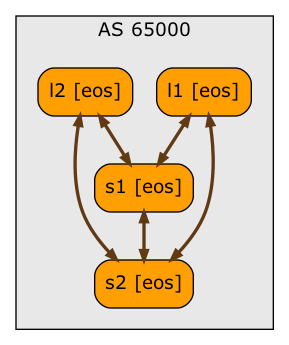… updated on Thursday, November 3, 2022 16:36 UTC
More Arista EOS BGP Route Reflector Woes
Most BGP implementations I’ve worked with split the neighbor BGP configuration into two parts:
- Global configuration that creates the transport session
- Address family configuration that activates the address family across a configured transport session and changes the parameters that affect BGP updates
AS numbers, source interfaces, peer IPv4/IPv6 addresses, and passwords clearly belong to the global neighbor configuration.
BGP policies like route maps and prefix lists clearly belong to the address family configuration, but what about route reflector clients and next-hop processing?
One might argue that these parameters belong to the address family configuration. After all, they affect BGP updates within an address family. One might also argue that having different route reflector topologies for individual address families doesn’t make sense. That might have been the argument that caused Arista to implement neighbor route-reflector-client and neighbor next-hop-self commands on the global BGP configuration level. I would have no problem with that if only they were implemented consistently.
As I described in April 2022, Arista EOS takes next-hop-self a bit too literally. That option also changes the next hops on reflected routes. No problem; one can also use the bgp route-reflector preserve-attributes command to fix it. The “only” remaining problem is that this command does not work on all address families, and there’s no way to fix that.
Here are the relevant parts of the global BGP configuration netlab created when I started testing the leaf-and-spine EVPN topology with Arista EOS:

BGP session topology
router bgp 65000
bgp advertise-inactive
bgp log-neighbor-changes
no bgp default ipv4-unicast
no bgp default ipv6-unicast
router-id 10.0.0.7
bgp cluster-id 10.0.0.7
bgp route-reflector preserve-attributes
!
neighbor 10.0.0.5 remote-as 65000
neighbor 10.0.0.5 description l1
neighbor 10.0.0.5 update-source Loopback0
neighbor 10.0.0.5 next-hop-self
neighbor 10.0.0.5 route-reflector-client
neighbor 10.0.0.5 send-community standard extended
!
neighbor 10.0.0.6 remote-as 65000
neighbor 10.0.0.6 description l2
neighbor 10.0.0.6 update-source Loopback0
neighbor 10.0.0.6 next-hop-self
neighbor 10.0.0.6 route-reflector-client
neighbor 10.0.0.6 send-community standard extended
So far, so good. IPv4 works; the next hops are correct. Now for the EVPN part:
router bgp 65000
address-family evpn
!
neighbor 10.0.0.5 activate
neighbor 10.0.0.6 activate
neighbor 10.0.0.8 activate
Looks simple, right? The only problem is it doesn’t work. No routes are reflected between L1 and L2. I tried all sorts of things, and the only way to get the EVPN route reflector to work was to remove the neighbor next-hop-self from the IBGP neighbors.
It looks like EVPN BGP AF processing ignores the bgp route-reflector preserve-attributes setting. As the change in the next hop would bring the traffic to the spine switch (which did not have the VXLAN interfaces to handle it), the spine switch decided not to send the updates.
Interestingly, you can configure neighbor next-hop-unchanged within the EVPN address family. Still, it only applies to EBGP neighbors (you need that when you believe in building EBGP-only data centers). It does not affect the neighbor next-hop-self global setting.
OK, so I gave up and removed all the neighbor next-hop-self commands from the global configuration. All of a sudden, EVPN worked like a charm, but of course, the test IBGP+EBGP topology wouldn’t work because the next hops of some routes (EBGP neighbors) wouldn’t be reachable.
In the end, I was forced to use the BGP equivalent of the Swiss Army knife: a route map that sets the next hop (netlab commit), resulting in the following configuration:
route-map next-hop-self-ipv4 permit 10
match route-type external
set ip next-hop peer-address
!
route-map next-hop-self-ipv4 permit 20
!
address-family ipv4
!
network 10.0.0.7/32
!
neighbor 10.0.0.5 activate
neighbor 10.0.0.5 route-map next-hop-self-ipv4 out
neighbor 10.0.0.6 activate
neighbor 10.0.0.6 route-map next-hop-self-ipv4 out
More Information
- Want to reproduce my tests? Install netlab and use Arista cEOS containers.
- Want to learn more about EVPN? There’s probably no better source than EVPN Deep Dive webinar with Dinesh Dutt (the author of BGP in the Data Center), Lukas Krattiger (the author of Building Data Centers with VXLAN BGP EVPN), and Krzysztof Grzegorz Szarkowicz (the author of MPLS in the SDN Era)
Revision History
- 2022-11-03
- Arista EOS supports per-AF next-hop-self in release 4.29.0F

Unfortunately this is not the only unexpectedly global-only BGP configuration - redistribution of connected and static routes, until recent versions (4.27 or 4.28?), were not configurable per address-family and so required both IPv4 and IPv6 policies to share a route-map
Hi Ivan, Did you try adding 'always' to preserve-attributes?
bgp route-reflector preserve-attributes always
If you do that, I think the nexthop should be preserved.
Thanks for the suggestion. No change.
The problem is that 'next-hop-self' applies to EVPN AF while 'bgp route-reflector preserve-attributes' does not, and I found no knob to undo 'next-hop-self' on IBGP sessions for EVPN AF.
Hi Ivan. One more thing that might work. Configure
next-hop resolution disabled
under
address-family evpn
Thanks a million for your efforts, but this does seem like throwing spaghetti at the wall to see what sticks ;)... and no, it doesn't work.
Can you share the version of EOS that you are using? I will track this issue and fix it.
Did you happen to try "bgp next-hop-unchanged"?
address-family evpn bgp next-hop-unchanged neighbor spines activate !Yes, among many other similar things. No impact :(
Thank you! Ivan
It has to be something with the version, I run multiple IP fabrics with a Arista spines using iBGP as RRs and haven't seen this issue.
My testing with vEOS and cEOS has been positive as well with this same design.
Hi Ivan,
It seems that you have been heard! ;)
The new 4.29.0.2F EOS version which has just been released supports BGP NHS per AFI (only IPv4 & IPv6 for the moment...).
Here an extract from the public release note: "The next-hop-self option can be configured in the address family mode for IPv4 and IPv6 unicast address families. (689914)"
PS: I'm an Arista employee...
Awesome. Thanks a million for the update!